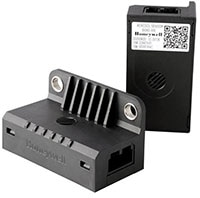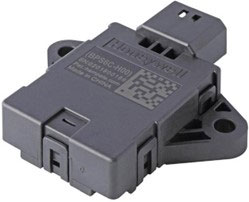Safety-First Approach To EV and Battery Storage with Honeywell Sensors
Developing electrified applications requires rigorous compliance with safety standards to ensure reliable and user-friendly experiences. After all, nobody wants to experience a runaway thermal event that could lead to smoke or even fire when driving an electric vehicle (EV) or operating a mobile device while flying in a jet at 30,000 feet. That's why product designers of EV batteries and energy storage systems need exceptionally accurate and reliable sensors that can ensure safe operation without impeding performance.
Lithium-ion (Li-ion) batteries are remarkable for their high energy density and efficiency, which are essential for EVs and a range of other electronic applications. But, as the National Fire Protection Association points out, "the likelihood of them overheating, catching on fire, and even leading to explosions increases when they are damaged or improperly used, charged, or stored."
Considering the millions of EVs on the road worldwide and the billions of Li-ion powered mobile devices in use, incidents of runaway thermal events are relatively sparse, but not insignificant—about two incidents per week on U.S. flights, according to FAA data. As more electrification applications are developed, the raw number of such incidents is certain to increase, any of which could negatively impact sales for vendors.
Furthermore, over 90% of Li-ion battery demand is now attributed to the energy sector, driven by higher energy densities, longer lifetimes, and dramatic cost reductions since 2010, outclassing alternatives for power storage applications, according to the International Energy Agency (IEA). Utility-scale battery energy storage systems (BESS) are being adopted at a quickening pace as countries and businesses strive to achieve net-zero emissions goals.
Designing safety-first electrification applications
Demand for Li-ion batteries is growing across industries, making it essential that product designers take a safety-first approach to employing them in their applications.
Thermal runaway events occur when a battery experiencing increasing temperature generates heat that can potentially lead to fire or even explosion. These events can be caused by excessive charging, physical damage that compromises internal structure, and short circuits resulting from manufacturing defects.
Li-ion batteries may degrade due to excessive discharging, external short circuits, extreme environmental heat, and other factors.
Honeywell Sensing and Productivity Solutions provides current and battery safety sensors that application designers can leverage to enhance safety, efficiency, and performance. These sensors monitor and manage current flow and battery health. They can be utilized in battery management systems for EVs and BESS, providing early problem detection, accurate measurements, and customizable features for integration into various other applications.
The company's CSHV Series open-loop current sensors (Figure 1) use Hall effect and proprietary Honeywell technology for performance and reliability in current sensing applications to measure direct current (DC) in the range of ±100 ADC to ±1500 ADC. They provide an analog voltage output proportional to current flow, facilitating integration in multiple electric vehicle applications, such as current sensing in battery management systems (BMS), battery disconnect units (BDU), power distribution units (PDU), fault detection, and isolation.
 Figure 1: Honeywell's CSHC Series sensors use open-loop Hall effect technology. (Image source: Honeywell)
Figure 1: Honeywell's CSHC Series sensors use open-loop Hall effect technology. (Image source: Honeywell)
Honeywell’s CSNV series current sensors use closed-loop Hall effect technology to provide high accuracy and stability over a wide temperature range. They are designed to measure current flow in battery management systems, electric vehicles, energy storage systems, and other applications requiring high accuracy and reliability. They can be used to detect sensor and host system faults, as well as over-range and under-range supply voltage. They are available in three models:
- CSNV500 units can measure up to ±500 A with a total accuracy of <±0.5%
- CSNV700 devices (Figure 2) can measure up to ±700 A with a total accuracy of <±0.5%
- CSNV1500 can measure up to ±1500 A with a total accuracy of <±1%
 Figure 2: A Honeywell CSNV700 series current sensor. (Image source: Honeywell)
Figure 2: A Honeywell CSNV700 series current sensor. (Image source: Honeywell)
The CSSV series advanced fluxgate current sensors (Figure 3) combine fluxgate and open-loop Hall effect technologies. Designed for safety-critical applications, these sensors incorporate two independent sensing and data processing circuits for sensing and diagnostic functionality to provide precise current measurements. They are engineered to detect current leakage, fault detection, and isolation within EV drive control systems.
 Figure 3: A CSSV series advanced fluxgate current sensor. (Image source: Honeywell)
Figure 3: A CSSV series advanced fluxgate current sensor. (Image source: Honeywell)
The BAS Series battery safety sensors (Figure 4) are designed to detect and report thermal runaway events in enclosed Li-ion battery packs by measuring the presence and concentration of aerosols, such as smoke, liquid, and debris. They measure and report aerosol concentration from 200 µg/m³ to 10000 µg/m³ using the controller area network (CAN) communication protocol. They have a factory-programmed, thermal runaway warning threshold of 5000 µg/m³ and can be integrated into electric vehicles and energy storage systems.
 Figure 4: A Honeywell BAS series sensor measures smoke, liquid, and other aerosol concentrations in Li-ion battery packs. (Image source: Honeywell)
Figure 4: A Honeywell BAS series sensor measures smoke, liquid, and other aerosol concentrations in Li-ion battery packs. (Image source: Honeywell)
The BPS series battery safety pressure sensors (Figure 5) are designed to detect and report early signs of thermal runaway events in Li-ion battery packs by monitoring pressure changes in EV battery packs and energy storage systems. They detect battery pressure changes spanning 50 kPa to 300 kPa absolute pressure, and have configurable warning thresholds for both absolute pressure and pressure rate of change.
 Figure 5: Honeywell’s BPS series battery safety sensors provide early detection of Li-ion thermal runaway events. (Image source: Honeywell)
Figure 5: Honeywell’s BPS series battery safety sensors provide early detection of Li-ion thermal runaway events. (Image source: Honeywell)
Conclusion
Expanding demand for electrification applications is increasing the already widescale adoption of Li-ion batteries. However, product designers need to integrate sensors that can enhance the safety, reliability, and efficiency of EV battery packs and energy storage systems, ensuring they operate within designated parameters and respond promptly to any irregularities. Honeywell sensors work together to ensure optimal performance and safety by providing the information to manage charging and discharging processes, control thermal management systems, and execute safety protocols when necessary.

Have questions or comments? Continue the conversation on TechForum, DigiKey's online community and technical resource.
Visit TechForum









